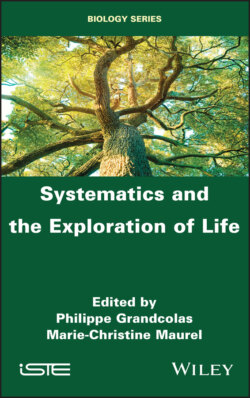Читать книгу Systematics and the Exploration of Life - Группа авторов - Страница 17
1.5. Principles of geometric morphometrics
ОглавлениеWe are limiting ourselves here to the morphometric framework, in which the morphology of a biological structure is described by a configuration of p landmarks (Bookstein 1991; Rohlf and Marcus 1993; Adams et al. 2004). These landmarks, ideally defined on anatomical criteria, must be recognizable on all n specimens of the sample. Their digitization in k = 2 or 3 dimensions (depending on the geometry of the object considered) provides a description of each specimen as a series of pk coordinates. The comparison of the two or more objects thus characterized is done by superimposing their landmark configurations. The method most commonly used today is the Procrustes superimposition (Dryden and Mardia 1998). The underlying idea is that the shape of an object can be formally defined as the geometric information that persists once it is freed from differences in scale, position and orientation (Kendall 1984). These non-informative differences in relation to the shape are eliminated by scaling, translation and rotation, so as to minimize the sum of the squared distances between homologous landmarks (Figure 1.2). The residual variation provides a measure of the shape difference between the two objects, the Procrustes distance, which constitutes the metric of the shape space. In this space, each point corresponds to a shape, and two shapes are all the more similar, the smaller the Procrustes distance is between the points that represent them.
Figure 1.2. Principles of geometric morphometrics illustrated for the simple case of triangles (three landmarks in two dimensions). For a color version of this figure, see www.iste.co.uk/grandcolas/systematics.zip
COMMENT ON FIGURE 1.2. – a) Two objects described by homologous configurations of landmarks are subjected to three successive transformations eliminating the differences in position (I), scale (II) and orientation (III), in order to extract a measure of their shape difference: the Procrustes distance. b) The Procrustes distance is the metric of the shape space, a non-Euclidean space in which each point corresponds to a unique shape. In applied morphometrics, researchers work with a space related to the shape space called the Procrustes (hyper)hemisphere. c) The non-linearity of this space requires projecting data onto a tangent space before testing biological hypotheses by using traditional statistical methods.
Empirical applications of morphometrics are generally carried out in another space, the Procrustes (hyper)hemisphere, mathematically linked to the shape space, and efficiently estimating distances between shapes when the studied morphological variation is small compared to the possible theoretical variation (which is the case for biological applications). The shape space and the Procrustes hemisphere have non-Euclidean geometries and, for practical reasons (the application of standard statistical methods), the distribution of objects in either of these spaces is approximated by their distribution in a tangent space of the space under consideration, at the point corresponding to the mean shape of the sample (see Dryden and Mardia (1998) for more details).
